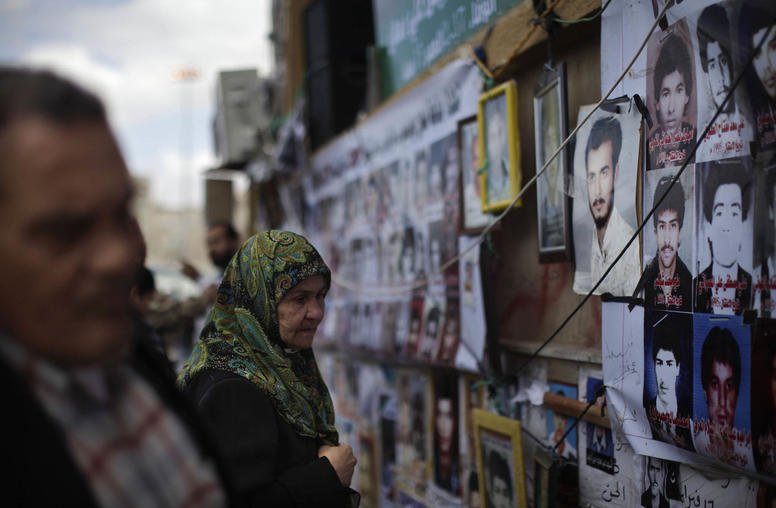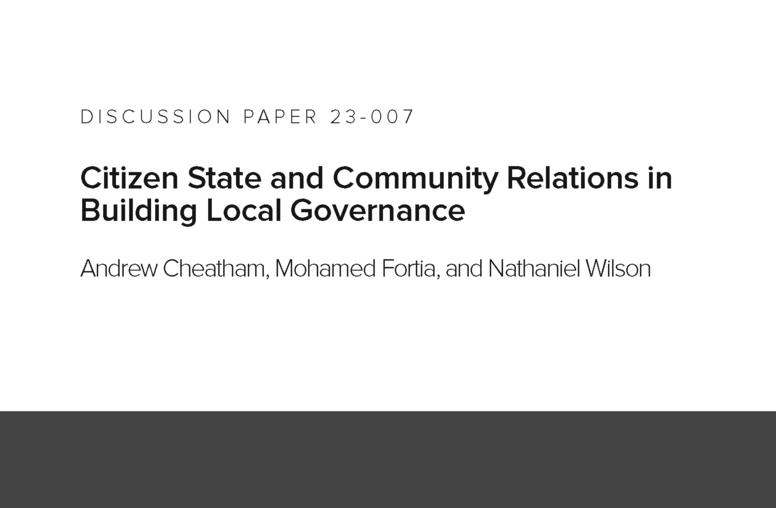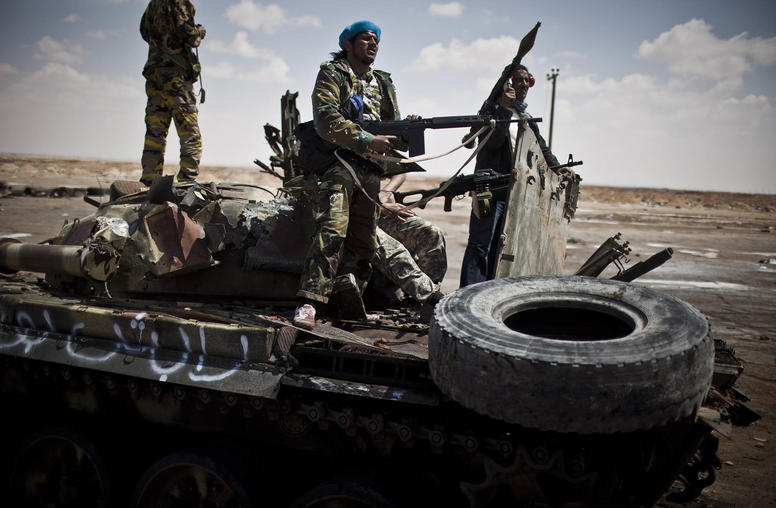In Libya, Hope Springs from Youth and Local Communities
Young Libyans Fuel Local Civil Society Groups and Peace Efforts
More than two years after the United Nations began leading an internationally backed peace process for Libya, that effort faces severe challenges. Rival Libyan regimes still claim national authority, and battles among hundreds of militia groups continue. Amid the turmoil, however, young Libyans are leading peacebuilding efforts in their local communities. Two dozen Libyan youth leaders gathered in Tunis over the past two months to better organize their initiatives. With national-level peace efforts stalled, such local reconciliation offers a way for Libyans to stabilize parts of the country and gradually lay foundations for wider peacebuilding.

Libya’s Complex Crisis
Libya’s upheaval is in its seventh year since a nationwide uprising toppled the authoritarian ruler, Muammar Qaddafi. An eastern regime, based in Tobruk, is supported by the Libyan National Army, an alliance of tribes and former military officers. In the west, armed groups support a rival government in Tripoli. Other factions run smaller zones along the coast or in the desert interior, often fighting to control Libya’s lucrative oil fields, pipelines and smuggling routes. A U.N.-backed Government of National Accord, meant to unify the factions, has been unable to establish real authority.
In December, the main leader in the east, Libyan National Army commander Khalifa Haftar, declared that the mandate for the U.N.-backed unity government had expired, and violence has continued across the country. The United Nations is backing a plan to hold elections this year, a step that faces logistical and political challenges, and may risk greater violence.
As Islamic State extremists have been forced out of Iraq and Syria, that group and others affiliated with al-Qaeda have sought to strengthen their positions in Libya, drawing periodic U.S. military strikes. Libya’s turmoil has uprooted hundreds of thousands of people and killed thousands of civilians and desperate foreign migrants who transit the country as they try to reach Europe.
“The instability in Libya and North Africa may be the most significant near-term threat to U.S. and allies’ interests on the continent,” posing risks to Europe and other neighboring regions, said the top U.S. military commander for Africa, General Thomas Waldhauser, in congressional testimony last year. Analysts for years have noted ways in which the Libyan conflict has exported weapons, terrorist attacks or economic instability to Tunisia, Mali, Niger and other countries of North Africa and the Sahel.
Hope from Libya’s Youth
The continued conflict has frustrated young Libyans’ hopes for better lives following the 2011 revolution that ousted Qaddafi. Of Libya’s 6.5 million people, more than one million, about 17 percent, depend on humanitarian aid to survive, the United Nations says. Youth unemployment has hung for years around 38 percent, according to the World Bank, which means that many Libyan youth have become easy recruitment targets for militias or extremist groups, who offer them an income and a sense of belonging in a country that is increasingly short on both.
But amid Libya’s web of communal conflicts—among tribal, regional and ethnic groups—a generational shift also is underway. In a nation where tradition reserves leadership roles for a community’s elders, many Libyan youth are rejecting communal divisions and stereotypes that help fuel the continued violence. Young Libyans have taken the lead in developing the country’s first generation of civil society organizations, many working to improve education, human rights and better relations among communal groups.
Since 2011, USIP engagement in Libya—including research, community dialogues and capacity building—has found many young Libyans eager to reach across their country’s communal divisions. The Institute aims to harness this desire to help Libyans build peace at the grassroots level while international efforts work with political elites to end the violence. This spring, USIP gathered 24 active youth from disparate regions of the country in a series of training workshops to help them advance their efforts to bridge divides in their communities.
Salim’s Story
One of the Libyan trainees is “Salim,” a 24-year-old university student, from a family of modest means who works energetically with charity organizations in the coastal city of Misrata. He asked that his real name not be published to avoid being targeted by hardline factional fighters who would oppose his peacebuilding efforts.
When Libyans rose up against the Qaddafi regime in 2011, Misrata was at the center of the revolt. Salim and his fellow Misratans fought Qaddafi’s forces in the most intense combat of the revolution. It was “a battle against oppression,” Salim said, meant to bring freedom and hope for Libyans.
After Qaddafi’s ouster, fighting continued among groups across Libya—often as retaliation between former pro-Qaddafi and anti-Qaddafi forces. Salim and other Misrata youth battled armed groups from communities that had defended Qaddafi, such as the oasis town of Bani Walid, southwest of Misrata. Three years after Qaddafi’s overthrow, militias from the two locales still were feuding, and the Misrata faction was holding more than 50 Bani Walid men as prisoners.
But Salim had friends from Bani Walid. Late in 2014, fighters from the two factions met for talks, and Salim took part. “I realized that those personal connections to these guys [from Bani Walid] were still important to me,” Salim said. “And talking with them, I understood that their own situation was not simple. If they fought for the Qaddafi regime, it was because somehow the regime coerced them to take up arms, or sometimes because they felt threatened and with no protection.”
Salim helped negotiate the Misratans’ release of seven Bani Walid youth. And he took a potentially dangerous step. Now believing that Libya’s post-2011 violence was ripping the nation’s social fabric, Salim withdrew from further fighting—a step that some of his former comrades might regard as treachery.
“I refuse to take part in an act of vengeance,” Salim said during a USIP training session. “That is not what 2011 was all about, and if we can be reminded that our aspiration was freedom and a better life, we might start thinking differently.”
The Battle Between Misrata and Tawergha
This spring, Salim traveled to Tunis, joining other young Libyan civic activists for the training workshops sponsored by USIP. There, he met Abdussalam—two young men from opposite sides of one of Libya’s most persistent conflicts.
Abdussalam is from Tawergha, 24 miles south of Misrata. During the 2011 revolution, Qaddafi’s forces used Tawergha as a base from which to pound Misrata. After Qaddafi fell, Misrata fighters retaliated, forcing an estimated 40,000 Tawergha residents to flee their city. Tawergha’s people now live in squalid camps while their hometown stands an empty ruin. When Libya’s U.N.-backed Government of National Accord arranged for Tawergha’s people to return in February, following a U.N-brokered agreement, armed men blocked the roads and gunfire erupted, forcing the displaced families back to the camps.
In Tunis, Salim and Abdussalam joined other Libyan youth leaders in workshops conducted by USIP and a Tunisian partner organization, MKSS. They learned conflict resolution methods and techniques for using videos and cellphone apps to promote their efforts to build peace in their home communities. The trainees came from areas as varied as Tripoli and Misrata in the west, Benghazi and Derna in the east, and Fezzan in Libya’s south—all regions that are dominated by rival armed factions in the war.
The trainees “gained communication, collaboration and conflict resolution skills,” said USIP’s Nicole Firlik, who is leading the youth engagement project. But more important, she said, “is that they can build on the trust gained in the workshop and learn from each other moving forward. It will be essential (for them) to engage each other’s networks to advance their positive discourse of peaceful alternatives to violence.”
USIP: Supporting Reconciliation
A USIP team helped the Libyan youth design local initiatives for their communities that can advance dialogues to reduce or avert violence. The Institute’s team will continue to mentor the youth leaders in developing those projects—including an effort by Salim and Abdussalam to move the peers in their two communities toward reconciliation. They are working together on a first step, to break down the widespread, negative stereotypes in each community about the other.
USIP’s work in Libya holds recognizes youth as instrumental to any peace process—a fundamental principle of conflict resolution that increasingly has been understood by policymakers and governments. Libya will remain unstable if stabilization efforts exclude youth. Bottom-up approaches to building peace must at some point link to national policies and institutional reconciliation efforts. Nevertheless, the political dialogue and possible elections in Libya are unlikely to result in stability if they focus on striking a balance merely between political factions instead of galvanizing a process built by civic participation and the endorsement of the next generation. To build peace in Libya, it is crucial to support and nurture the efforts of Libyan youth who are seeking to break a violent status quo, and to reach across their country’s divides.


